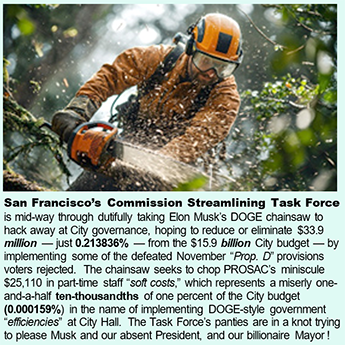 Printer-friendly PDF file
Printer-friendly PDF fileSeptember 9, 2025
Penny Wise, Pund Foolish Quibbling Iver 0.213836% of City Budget
Commission Streamlining Task Force Runs Amok
Is the Task Force Attempting to Implement Provisions in “Prop. D”
That Voters Rejected, When They Passed "Prop. E” Instead?
Concerns About an Attack on Democracy, and Robust Oversight
by Patrick Monette-Shaw
If eternal vigilance is the “price of liberty, freedom, or public transparency,” is just two-tenths of one percent of the City Budget too onerous a price to spend to maintain public accountability, when only the “cost” side of the equation was assessed — given the complete absence of a full cost-benefit analysis?
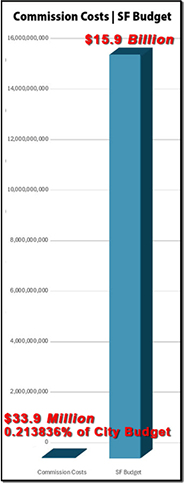 With release of the Board of Supervisors Budget and Legislative Analyst’s (BLA) skimpy 15-page report, “Board and Commission Annual Financial Cost Analysis” (plus 23 pages of tables in Appendices) on September 1st to the “Commission Streamlining Task Force,” San Franciscans have now learned that the probably over-estimated $33.9 million in costs of operating San Francisco’s approximately 112 Board and Commission policy bodies represents an infinitesimally small cost of City governance. The $33.9 million represents a mere two-tenths of one percent — yes, just 0.213836% — of the $15.9 billion FY 2024–2025 City Budget. Efforts now underway to eliminate or combine Commissions represent penny wise, but pound foolish, quibbling.
With release of the Board of Supervisors Budget and Legislative Analyst’s (BLA) skimpy 15-page report, “Board and Commission Annual Financial Cost Analysis” (plus 23 pages of tables in Appendices) on September 1st to the “Commission Streamlining Task Force,” San Franciscans have now learned that the probably over-estimated $33.9 million in costs of operating San Francisco’s approximately 112 Board and Commission policy bodies represents an infinitesimally small cost of City governance. The $33.9 million represents a mere two-tenths of one percent — yes, just 0.213836% — of the $15.9 billion FY 2024–2025 City Budget. Efforts now underway to eliminate or combine Commissions represent penny wise, but pound foolish, quibbling.
As I wrote last year in the Westside Observer, Table 1 citing City Controller payroll data (excluding fringe benefits) illustrates that between Fiscal Year 2009–2010 and FY 2023–2024, the “bloat” in select City job classifications ballooned by $301.5 million, including $190 million in senior manager job classification codes, 0922 through 1167, and SFMTA senior managers in classification codes, 9172 through 9187, shown in Table 2.
Just 5 of 56 City Departments — the Airport, City Administrator’s Office, SFMTA, SFPUC, and the Human Services Agency — accounted for fully $80.4 million of the $301.5 million bloat in manager increases since 2010, shown in Table 3.
Why aren’t TogehterSF Action, Blueprint-SF Action, and Kanishka Cheng and her husband Jay Cheng, and their billionaire Astroturf ballot measure backers, trying to reign in excessive growth in City managers, and focusing instead on eviscerating our Boards and Commissions participatory oversight of City Hall?
After all, the $301.5 million in increased manager bloat represents a heftier 1.9% of the City’s $15.9 billion budget, and cutting excessive manager and patronage jobs should be much, much simpler than getting voters to give up long-cherished beliefs in transparent, accountable City governance.
It appears the billionaire backers of “Prop. D” last November led by the Astroturf group “TogetherSF Action” and Kanishka Cheng had their panties in a knot over the paltry 0.213836% slice of the cost of City governance. The $33.9 million for robust public oversight of City government is essentially chump change. Even billionaire Mayor Lurie knows this.
The political slogan “It’s the economy, stupid” may be a tired political cliché, but clichés are created for good reason. The slogan still serves as a reminder that voters’ personal economic situations and the overall health of the economy are the most important factors influencing voters decisions, and remain a primary concern.
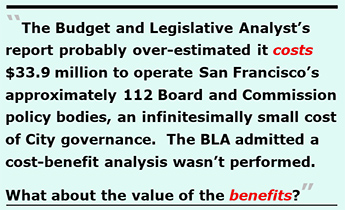 But at this point, San Franciscans may need a new cliché for another public concern: “It’s about retaining public transparency of City governance, stupid.” Savvy readers of San Francisco’s political corruption know all too well that without robust transparency of our City’s Boards and Commissions, City Hall will throw open its doors to public corruption. Just think of the Mohammed Nuru scandal in 2020 involving the Department of Public Works that lead to Nuru’s seven-year Federal prison sentence.
But at this point, San Franciscans may need a new cliché for another public concern: “It’s about retaining public transparency of City governance, stupid.” Savvy readers of San Francisco’s political corruption know all too well that without robust transparency of our City’s Boards and Commissions, City Hall will throw open its doors to public corruption. Just think of the Mohammed Nuru scandal in 2020 involving the Department of Public Works that lead to Nuru’s seven-year Federal prison sentence.
Unfortunately, the “Commission Streamlining Task Force” that was created following passage of “Prop. E” last November appears to suffer from myopia, and appears to be dangerously close to eliminating oversight of many boards and commissions, which may well lead to further corruption running rampant. After all, corruption flourishes in secrecy.
The phrase “Democracy Dies in Darkness” — the masthead tagline for The Washington Post popularized by journalist Bob Woodward in his writings about government secrecy, had originated in a judge’s ruling on a First Amendment case and has served as a public-facing slogan and a reminder of the Post’s newspaper’s watchdog role, especially during both Donald Trump administrations — comes to mind. Some San Francisco observers have already concluded the Streamlining Task Force’s recommendations to eliminate some Boards and Commissions in our City are thinly disguised attacks on the public’s right-to-know about what our government is doing on our behalf!
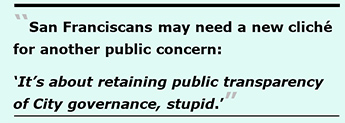 And now it’s the “Streamlining Task Force” that appears to have their panties in a knot!
And now it’s the “Streamlining Task Force” that appears to have their panties in a knot!
Upcoming Task Force Schedule
After eight months of developing so-called “templates” and “evaluation criteria” to assess each of the City’s 112 Boards and Commissions, body-by-body actual deliberations are being crammed into just five meetings of the Streamlining Task Force. The first meeting on September 3 considered 10 oversight bodies in the “Public Safety” category. The September 17 meeting will address 20 bodies in the “Infrastructure, Climate, and Mobility” category, while the October 1st Task Force meeting is set for deliberations of 31 bodies in the “Housing and Economic Development” group.
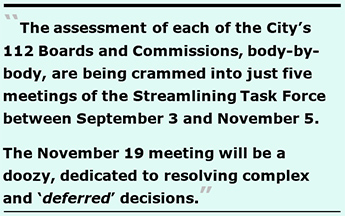 On October 15, the Task Force will assess the initial outcome recommendations for 29 “Public Health and Wellbeing” oversight bodies, and the final meeting at which individual bodies will be discussed is for 23 bodies in the “General Administration and Finance” category on November 5.
On October 15, the Task Force will assess the initial outcome recommendations for 29 “Public Health and Wellbeing” oversight bodies, and the final meeting at which individual bodies will be discussed is for 23 bodies in the “General Administration and Finance” category on November 5.
The November 19 meeting will be a doozy, dedicated to resolving complex and “deferred” decisions the Task Force was unable to resolve during its previous meetings, along with potential “operational improvements” recommended for specific, or all, Boards and Commissions.
That’s if things go as planned and agendized.
At its August 20 meeting, the Task Force didn’t hear four of its 11 scheduled agenda items, including Item #6 involving the BLA’s report (a discussion-only agenda item) on the costs of each of the 112 Boards and Commissions. City Administrator Staff have said two of the agenda items not heard won’t be rescheduled — Item #9 “Staff Working Groups” and #10 “Legally Required Bodies,” both of which were agenda action items — but maybe the BLA report will be re-scheduled for a subsequent meeting. As it is, the BLA report was not rescheduled for the September 3 Task Force meeting, and as this article went to press on Tuesday, September 9, it’s not scheduled on the September 17 agenda, either. If it’s never rescheduled, it will have been of scant value for the Task Force. It’s unclear whether that report will be presented at any of the last three Task Force meetings in October and November devoted to focusing on recommendations for the remaining 83 of the 112 policy bodies.
Next, the September 3 Task Force meeting failed to hear Agenda Item #8, “Sheriff’s Department Oversight Board and Inspector General (SDOB),” which was also an agenda action item. So the fate of the SDOB will presumably be re-calendared — unless City Administrator staff decide not to discuss that body at all, knowing that is sure to involve time-consuming extended public comment and slowing down adhering to meeting schedules, given the great public interest in not eliminating the SDOB and combining it with the “Department of Police Accountability” under the Police Commission. As this article went to press on September 9, the SDOB discussion has not been re-scheduled on the Task Force’s September 17 meeting agenda, either. Will it be heard on November 19?
The main cause of not getting all the way through the last two meeting agenda’s is because the City Administrator’s staff have been unable to locate a City Hall meeting room for meetings longer than two-and-a-half hours, so planned agenda items face being cut off with scheduled items not heard.
BLA’s One-Sided Cost Analysis
Compounding the Streamlining Task’s Force’s myopia, the BLA appears to have had its own myopia.
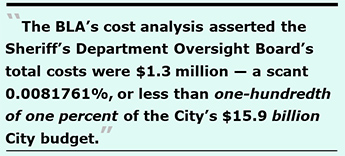 The BLA’s cost analysis was released a day late, and only a day before the Task Force’s September 3 meeting to make initial recommendations on whether to retain, eliminate, or consolidate 10 Public Safety bodies — including the Police and Fire Commissions, and the Sheriff’s Department Oversight Board (SDOB). That left the Task Force with inadequate foreknowledge that the SDOB’s total costs were just $1.3 million — again, a scant 0.0081761%, or less than one-hundredth of one percent of the City’s $15.9 billion City budget for the current fiscal year. The Task Force ran out of time and didn’t evaluate the fate of the SDOB on September 3.
The BLA’s cost analysis was released a day late, and only a day before the Task Force’s September 3 meeting to make initial recommendations on whether to retain, eliminate, or consolidate 10 Public Safety bodies — including the Police and Fire Commissions, and the Sheriff’s Department Oversight Board (SDOB). That left the Task Force with inadequate foreknowledge that the SDOB’s total costs were just $1.3 million — again, a scant 0.0081761%, or less than one-hundredth of one percent of the City’s $15.9 billion City budget for the current fiscal year. The Task Force ran out of time and didn’t evaluate the fate of the SDOB on September 3.
The BLA’s report noted repeatedly that its data was derived from estimates provided by City Department staff for their respective governance commission or board using a Microsoft nine-tab worksheet distributed for department staff to fill out. The survey instrument in Microsoft Excel was sent to 118 Boards and Commissions, and 111 surveys were returned and used in the BLA’s analysis. It should be noted the data collected are simply estimates from staff who were left to their own devices to recall how much time they spent on average each month in the past year. All numbers collected were pure estimates, which the BLA admits could be higher or lower than the data reported. Few City staff ever track and record their time on individual tasks performed, with the exception of City Attorney’s who bill their time by the hour.
Of interest, the BLA evaluated “hard costs” of time spent by full-time staff assigned to support a Board or Commission, vs. “soft costs” of additional “less than full-time personnel” who provide support to a board or commission. Exhibit 5 on page 8 of the BLA report (which is actually a table, dressed up and titled as an exhibit), summarizes that the full-time “hard costs” were just $7 million of the $33.9 million total, while “soft costs” of part-time support from additional employees was $22.6 million, with an additional $4.3 million added in for non-personnel costs of having the 112 boards and commissions.
Although the BLA asserts the “hard cost” full-time departmental staff accounts for 20.6% of the $33.9 million in total board and commission costs, those hard costs represent just 0.0440252% (less than one-tenth of one percent) of the City’s $15.9 billion budget, while the part-time support staff “soft costs” account for 0.142138365% (just over a tenth of one percent) of the budget, and the non-personnel costs are 0.027044% (also less than one-tenth of one percent) of the City’s enormous budget.
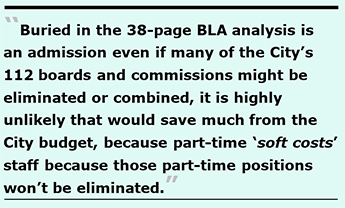 Buried in the 38-page BLA analysis is an admission that even assuming many of the City’s 112 boards and commissions might be eliminated or combined, it is highly unlikely that would save much of anything from the City budget, precisely because the $22.6 million for part-time “soft costs” staff who perform other job duties and only contribute small fractions of their time supporting boards and commissions, won’t be eliminated from the City’s payroll, even if their governing board and commission is, in fact, eliminated. The BLA reported: “Such positions are not likely to be deleted in the event of a board or commission elimination and thus would not represent hard savings for the City.”
Buried in the 38-page BLA analysis is an admission that even assuming many of the City’s 112 boards and commissions might be eliminated or combined, it is highly unlikely that would save much of anything from the City budget, precisely because the $22.6 million for part-time “soft costs” staff who perform other job duties and only contribute small fractions of their time supporting boards and commissions, won’t be eliminated from the City’s payroll, even if their governing board and commission is, in fact, eliminated. The BLA reported: “Such positions are not likely to be deleted in the event of a board or commission elimination and thus would not represent hard savings for the City.”
An inconvenient truth is that the $22.6 million in part-time costs won’t be eliminated entirely, because most part-time staff will keep their employment, regardless of the outcome of so-called Commission “streamlining” that the “Prop. D” screamers and schemers (to borrow a Joni Mitchell lyric) and their Astroturf network of billionaire-funded backers have wet dreams about. The five-member Streamlining Task Force seem all too eager to ignore this simple fact.
BLA Reports Minimal Cost Savings
By its own admission, the BLA reported on page 10:
“The financial impact of eliminating Charter-based boards or commissions is less than the annual financial cost for the same boards and commissions established through the Charter, or both Charter and an ordinance.”
Appendix 6 in the BLA report documents eliminating all 41 boards and commissions listed would save the City a mere $5 million annually — just 0.0314465% of the City budget (yes, just three-hundredths of one percent). Similarly, Appendix 7 in the BLA reports revealed that potentially combining those 41 boards and commissions with another oversight body would actually increase City costs by $422,881. Saving the entire $33.9 million simply won’t happen!
When the BLA conducted its analysis, it had no idea which Boards and Commissions were actually being considered for consolidation. While Appendix 7 suggested an increase in costs of $422,881 by combining 41 Boards and Commissions with others, Appendix 8 reported that combining 12 Commissions into just 6 Commissions would result in potentially $934,130 in annual savings for the City. The BLA offered no explanation for the conflicting estimates in Appendix 7 vs. Appendix 8.
The BLA did note on page 12:
“The functions performed by the board or commission and the associated department need to be identified and analyzed to determine what the associated department would still be responsible for even if their board or commission no longer existed.”
For good measure, the BLA added on page 13:
“To the extent that the Commission Streamlining Task Force considers specific consolidations, an analysis of both entities’ costs and functions will be essential.”
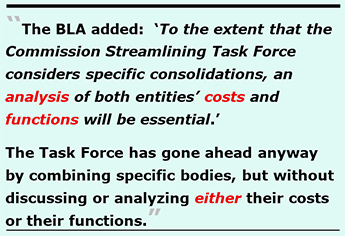 In other words, those key questions haven’t been answered, and it’s completely unclear who will conduct those two analyses, when, and at what additional cost — or if the Commission Streamlining Task Force will just charge ahead and recommend eliminating or combining bodies without a clear answer of how the mandated functions will be carried out, and by whom, and who will perform any additional “essential” specific cost analyses on combining any two specific bodies the BLA recommended be done.
In other words, those key questions haven’t been answered, and it’s completely unclear who will conduct those two analyses, when, and at what additional cost — or if the Commission Streamlining Task Force will just charge ahead and recommend eliminating or combining bodies without a clear answer of how the mandated functions will be carried out, and by whom, and who will perform any additional “essential” specific cost analyses on combining any two specific bodies the BLA recommended be done.
Also of interest, the BLA admitted on page 6 of its report that because data entered into the Excel worksheet surveys were “inconsistent or were unresponsive to the questions asked,” the BLA made an unspecified number of “adjustments” to survey responses — without explaining how many adjustments were made. So much for the BLA’s misplaced trust with the validity of the data entered!
Additional BLA Caveats Buried Online
On August 20, the BLA was scheduled to present a PowerPoint presentation in advance of releasing its full cost analysis of the 112 boards and commissions on September 3. Because meeting time ran out (since the Task Force couldn’t locate a City Hall room available for longer meetings), the scheduled presentation wasn’t made, and may not be rescheduled for a future meeting.
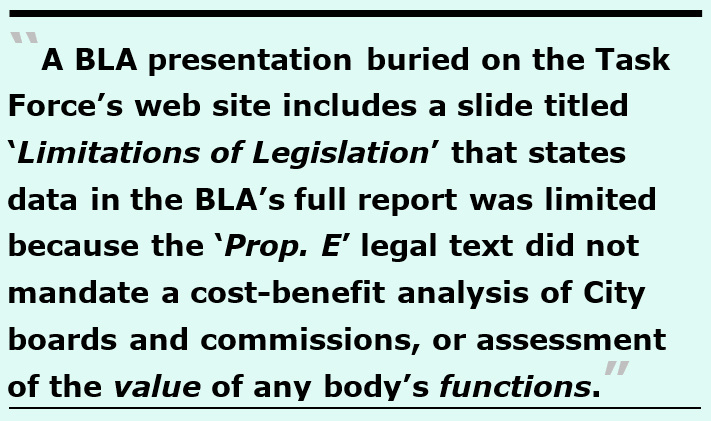 Of interest, that PowerPoint presentation included several important details on the limitations of data in the planned full analysis report.
Of interest, that PowerPoint presentation included several important details on the limitations of data in the planned full analysis report.
That presentation is buried on the Task Force’s August 20 meting agenda web page reserved for that particular meeting. People won’t be able to find that presentation easily, unless they know where to look to find it. A request placed with the City Administrator’s staff to place the presentation prominently alongside other key Streamlining Task Force major documents on the main web page was denied by City Administrator staff, who lamely asserted that because no other PowerPoint presentations are posted on the Task Force’s main web page, the BLA presentation won’t be co-located on the main web page adjacent to the BLA’s full report, either.
The slide titled “Limitations of Legislation” — referring to the legal text of “Prop. E” that created legislation requiring the BLA’s analysis — indicates data in its full report was limited because the legislation:
None of those data limitations and caveats were mentioned in the BLA’s 15-page (plus 23 pages of tables in the eight Appendices) final report.
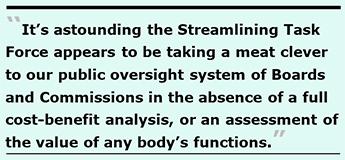 It’s astounding the Streamlining Task Force appears to be taking a meat clever to our public oversight system of Boards and Commissions in the absence of a full cost-benefit analysis. Lacking any assessment of the value of board and commission functions, the Task Force is throwing darts at the wall to see what sticks, and what they can get away with.
It’s astounding the Streamlining Task Force appears to be taking a meat clever to our public oversight system of Boards and Commissions in the absence of a full cost-benefit analysis. Lacking any assessment of the value of board and commission functions, the Task Force is throwing darts at the wall to see what sticks, and what they can get away with.
Even Streamlining Task Force Chair Ed Harrington cautioned the other four Task Force members on June 4 against “dramatically altering the city’s commission structure.”“Prop. E” was about streamlining, not radically overhauling, public governance. Absent a cost-benefit assessment of boards and commissions functions and value, the Task Force may radically overhaul our public governance, that Chair Harrington cautioned against doing!
Questionable Excel Data Collection
Of the 112 Boards and Commissions listed in Appendix #4 of the BLA’s cost analysis report, just 28 of them reported having full-time, “hard costs” staff employees, totalling $7 million in costs.
Because neither the BLA nor the Streamlining Task Force have posted online the Excel survey responses, the Westside Observer placed a public records request for 13 of the Excel files completed by Boards and Commission support staff in City Departments that we found of interest, curious about the full-time staff employees.
Of some interest, just for those 13 Excel files reviewed, the BLA’s Appendix listed no full-time costs for either the Police Commission or the Planning Commission, yet the Excel files for those two commissions show each Commission had three full-time job classification codes entered. The Police Commission’s Excel file listed their annual salaries and benefits for its three full-time staff, but failed to enter their FTE status, as the other 12 Commissions had entered. (FTE represents “full-time equivalent,” with “1.0” representing one full-time employees, vs. “0.5” representing a half-time employee.)
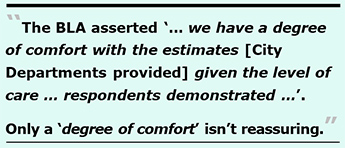 The BLA, sadly, gave too much credit where it wasn’t due about City staff who completed the BLA’s Excel survey workbooks. The BLA asserted “… we have a degree of comfort with the estimates [City Departments provided] given the level of care that many survey respondents demonstrated in preparing their annual financial cost estimates.”
The BLA, sadly, gave too much credit where it wasn’t due about City staff who completed the BLA’s Excel survey workbooks. The BLA asserted “… we have a degree of comfort with the estimates [City Departments provided] given the level of care that many survey respondents demonstrated in preparing their annual financial cost estimates.”
Only a “degree of comfort”? That’s not reassuring, and almost laughable. Then the BLA found it necessary to make “adjustments” to the data? Take the Police Department’s response to the survey, for example.
Police Commission or Police Department staff may not have understood how to enter data into the BLA’s Excel spreadsheet template. Although the Excel file for the Health Commission contained a Row #54 titled “Total Annual Amount Per Position,” there was no such row in the Excel file returned for the Police Commission. Nor did the Police Commission’s Excel file have a Row #56, titled “Total Hours per Month” that use an Excel formula — =SUM(L14,L18,L22,L26,L30,L34,L38,L42,L47,L51) — to total up the 10 pre-defined rows where staff were tasked with data entry to enter the number of hours per month spent on a variety of different tasks related to supporting their given Commission. (The 10 survey questions are contained in Appendix #8 of the BLA’s report.)
Each of the 10 questions had four rows in Excel: One row for the narrative question, another row labeled “a” for the job classification code of the person performing the question asked, a third row “b” for the average number of hours per month on this function, and the fourth row, “c” for the annual salary and benefits of the person identified on Row “a.” Rather than entering the number of hours performed for that task on Row “b,” Police staff appeared to have entered data on the wrong “Questions” row, two rows above, leaving the Row “b” for all 10 tasks performed blank. Making matters 0worse, Row #56 storing the formula used to calculate the total number of hours a given staff member may have spent as a monthly “average” was also not in the Police Commission’s returned Excel file, as it was for the Health Commission. Even if the Police Commission had retained Row #56, the formula would not have added anything up, because the data had been entered two rows above the intended Row “b’s.”
The Police Commission wasn’t the only one. Another 11 of the 13 Commissions sampled also didn’t contain Row #54 or Row #56. Of the 13 Excel files obtained under a public records request, only the Health Commission’s Excel file contained both rows. When the Observer e-mailed BLA’s principal author, Fred Brousseau, seeking comments about why 12 of the Commission’s Excel files were missing rows #54 and #56, we never received a response or explanation Brousseau said he would provide.
Of interest, among just the 13 BLA Boards and Commissions BLA’s Excel files obtained, there were a total of 19 full-time “hard costs” positions listed, shown in the attached file, compared to a staggering 376 part-time “soft cost” employees returned from the same 13 Boards and commissions. This suggests that some of these bodies may have padded their part-time employee responses to appear to have more Departmental staff contributing to their respective boards.
Why would anyone believe the Port Commission and the Recreation and Parks Commission each need 60 part-time staff to help their Commissions prepare for meetings, while the Public Utilities Commission needs 95 part-time staff to help prepare for SFPUC meetings? Do the Streamlining Task Force members realize this is bonkers? Did the BLA ask why?
As well, of the 13 Excel file provided by the BLA, another secondary analysis shows that of the 19 full-time “hard costs” staff, there were just 5 professional secretaries who earned far less than $200,00 in salaries and benefits each, 5 senior City Managers each of whom earned well over $200,00 in salaries and benefits, and two Police Sergeants earning nearly $300,000 each in salaries and benefits, among other job classification codes.
Nine of the 19 full-time staff were paid well over $200,000 each, and one earned $337,000 (at the SFMTA, which is facing a massive budget shortfall, and San Francisco property owners are facing a parcel tax proposed by the Mayor to bail out the SFMTA)! It doesn’t appear the Streamlining Task Force is concerned about salaries of the full-time “hard costs” of Commission staff.
These 13 Commission “hard costs” staff are just the tip of the iceberg, since Excel files for the other 15 Commissions with full-time staff listed in the BLA’s Appendix #4 weren’t requested, or analyzed. It’s not yet known how many of the other 15 Commissions may also have full-time staff paid up to $200,000 or more each, and may be using non-secretarial job classification codes.
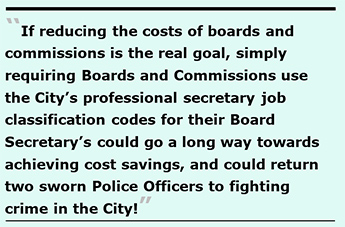 If reducing the costs of boards and commissions is the real goal, simply requiring Boards and Commissions use the City’s professional secretary job classification codes for their Board Secretary’s could go a long way towards achieving cost savings. It could also return two sworn Police Officers to fighting crime in the City!
If reducing the costs of boards and commissions is the real goal, simply requiring Boards and Commissions use the City’s professional secretary job classification codes for their Board Secretary’s could go a long way towards achieving cost savings. It could also return two sworn Police Officers to fighting crime in the City!
Streamlining Task Force Chair Ed Harrington spent 19 years of his City career as the City Controller, and four years as the SFPUC’s General Manager. So far, he hasn’t said a word about the BLA’s cost analysis, which observers find strange from someone with Harrington’s extensive financial background.
Task Force Public Safety Nonsense September 3
The San Francisco Bar Association rightly testified to the Streamlining Task Force:
“Independent governance of commissions requires that its members [be] independent. The selection of Commissioners should rest with an informed and transparent nomination process. No single branch of government should name all Commissioners.”
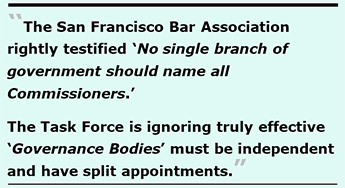 The Task Force is ignoring that truly effective “Governance Bodies” must be independent and have split appointments.
The Task Force is ignoring that truly effective “Governance Bodies” must be independent and have split appointments.
For the Police Commission, Fire Commission, and other Governance Bodies, this Streamlining Task Force is recommending replacing the short-list of three candidates recommended for City department heads, with an undefined, “consultative responsibility only” role, absent guarantees a given Mayor will engage with any Commission in a consultative, or bicameral-like, manner between the legislative and executive branches, let alone consultatively with any specific Governance Commission to preserve checks-and-balances governance.
The staff’s 43-page “Public Safety Bodies Recommendations” memo stated in Item 4-B on page 37, that the Police Commission can not take on the work of other bodies in its policy area. Therefore, this Task Force should stop attempting to transfer the Sheriff’s Department Oversight Board to the DPA under the Police Commission.
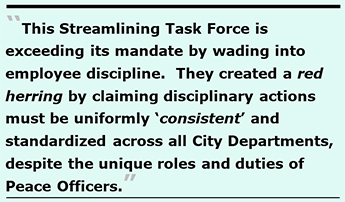 This Streamlining Task Force is exceeding its mandate by wading into employee discipline. They created a red herring by claiming disciplinary actions must be uniformly “consistent” and standardized across all City Departments, despite the unique roles and duties of Peace Officers. The Task Force should preserve police officers’ rights to a hearing on disciplinary matters before an Administrative Law Judge, and not hand all disciplinary matters to the Chief of Police — which would create a situation in which the police are allowed to police themselves. Clearly, Police Commission members are not trained in human resources processes, or in laws regarding employee discipline and employee due-process rights.
This Streamlining Task Force is exceeding its mandate by wading into employee discipline. They created a red herring by claiming disciplinary actions must be uniformly “consistent” and standardized across all City Departments, despite the unique roles and duties of Peace Officers. The Task Force should preserve police officers’ rights to a hearing on disciplinary matters before an Administrative Law Judge, and not hand all disciplinary matters to the Chief of Police — which would create a situation in which the police are allowed to police themselves. Clearly, Police Commission members are not trained in human resources processes, or in laws regarding employee discipline and employee due-process rights.
Since 2010, San Francisco has settled at least five wrongful termination lawsuits filed by Police Department staff, at a cost of over $2 million, not including time and expenses of City Attorney staff fighting the lawsuits. It’s not known what other costs were involved from claims filed by Police Department staff over other wrongful disciplinary actions.
The Commission Streamlining Task Force must abstain from being involved in City employee disciplinary processes. That’s not its mandate and Task Force members are not personnel and human resources specialists!
On September 3, the Task Force delayed making a recommendation on whether the Police, Fire, and Juvenile Probation Commissions should remain authorized by the City Charter, or be moved into the City’s Administrative Code. The delay in reaching a decision was principally because Task Force co-chair Jean Fraser wanted all three bodies taken out of the Charter.
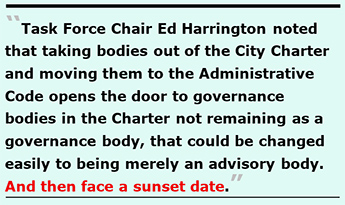 Fraser is the current CEO of the Presidio Trust, and a “San Francisco City Advisory Board Member” of the conservative SPUR organization. Task Force Chair Ed Harrington pointedly noted on September 3 that taking bodies out of the City Charter and moving them to the Administrative Code opens the door to governance bodies in the Charter not remaining as a governance body, that could be changed easily to being merely an advisory body. And then face a sunset date. Harrington stated that the only way to guarantee these three Commissions remain governance commissions is to keep them in the Charter.
Fraser is the current CEO of the Presidio Trust, and a “San Francisco City Advisory Board Member” of the conservative SPUR organization. Task Force Chair Ed Harrington pointedly noted on September 3 that taking bodies out of the City Charter and moving them to the Administrative Code opens the door to governance bodies in the Charter not remaining as a governance body, that could be changed easily to being merely an advisory body. And then face a sunset date. Harrington stated that the only way to guarantee these three Commissions remain governance commissions is to keep them in the Charter.
Just before the September 3 meeting was about to end, Harrington made sure to resolve this spat. On three successive “motions” about each of the three Commissions, the Task Force voted 3-to-1 to keep them in the Charter, with Vice-Chair Fraser being the sole dissenting vote. The Task Force may have reached the decision to keep them in the Charter only because they involved public safety bodies. Why is Fraser the outlier?
Commissions that are not in the Public Safety policy group may not be so lucky to receive City Charter protection during upcoming Task Force meetings on other policy categories!
Finally, the Task Force voted on September 3 to recommend stripping both the Police and Fire Commissions from being able to create a short-short list of three-nominees to become their next Department Heads, and hand the Mayor sole authority over who he chooses to run both departments. The Task Force is insisting both Commissions be forced to “align” to the Task Force’s templates and be reduced to “consultative responsibilities” only over who becomes their Department Head. This is one of the main reasons voters rejected “Prop. D” at the ballot box last November! “Prop. D” vote was designed to hand more power to a “strong mayor” form of government.
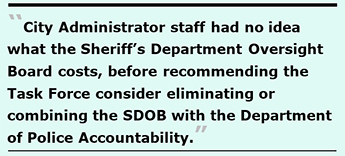 City Administrator staff supporting the Task Force had no idea what the “Sheriff’s Department Oversight Board” (SDOB) costs, before making its recommendation the Streamlining Task Force consider eliminating the SDOB, or combining it with the Department of Police Accountability under the Police Commission, based on the false premise of “efficiency.”
City Administrator staff supporting the Task Force had no idea what the “Sheriff’s Department Oversight Board” (SDOB) costs, before making its recommendation the Streamlining Task Force consider eliminating the SDOB, or combining it with the Department of Police Accountability under the Police Commission, based on the false premise of “efficiency.”
The “Public Safety Recommendation” memo reported for question 4 in the “Evaluation Criteria” section on page 41, that the SDOB could not reasonably be combined with another body in the “Public Safety” policy area category, and that no other policy bodies cover a similar topic or policy area that the SDOB covers. Further, page 37 documented that the Police Commission can not take on the work of other bodies in the Public Safety policy category. That hasn’t stopped the Task Force from attempting to transfer the Sheriff’s Department Oversight Board to the DPA, under the Police Commission.
The BLA costs report claimed the SDOB costs just $1.3 million — a mere 4% of the total $33.9 million in costs for all 112 Boards and Commissions. More importantly, the SDOB cost of $1.3 million represents just eight-one-thousandths of one percent, (0.008176%) — of the City’s now $15.9 billion annual budget. Yes, just eight-one-thousandths of one percent! It’s a ridiculously small price to pay to provide oversight of the Sheriff’s jails and other oversight functions.
Upcoming September 17 Task Force Bloodbath
On September 17, the Streamlining Task Force is scheduled to issue its initial recommendations on what to do with the 20 Boards and Commissions grouped into the “Infrastructure, Climate, and Mobility” category of public bodies. All 20 Boards are limped into a single agenda item, perhaps to prevent having to take public comment during multiple agenda items, and prevent speakers from testifying more than once.
This category primarily includes oversight bodies focused on the SFMTA, Publics Works, Public Utilities, and Recreation and Parks commissions, and the Port Commission. As far as can be discerned, none of these 20 bodies deal with “mobility” issues at all.
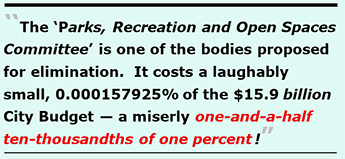 The “Parks, Recreation and Open Spaces Committee” (PROSAC) is one of the bodies proposed for elimination that will be debated. The BLA report acknowledges PROSAC costs just $25,110 annually — all of which are “soft costs” of part-time Park Department staff who will still keep their jobs performing other duties, which won’t save the City another red cent. That’s a laughably small, 0.000157925% of the $15.9 billion City Budget — a miserly one-and-a-half ten-thousandths of one percent! It’s also chump change in the scheme of things.
The “Parks, Recreation and Open Spaces Committee” (PROSAC) is one of the bodies proposed for elimination that will be debated. The BLA report acknowledges PROSAC costs just $25,110 annually — all of which are “soft costs” of part-time Park Department staff who will still keep their jobs performing other duties, which won’t save the City another red cent. That’s a laughably small, 0.000157925% of the $15.9 billion City Budget — a miserly one-and-a-half ten-thousandths of one percent! It’s also chump change in the scheme of things.
The City Administrator’s justifications to the Task Force for eliminating or combining these five to six governance bodies contain sheer nonsense, which you can read further, here.
Because the Task Force only discussed 9 of the 10 Public Safety bodies during its September 3 meeting before running out of time, it’s highly unlikely the Task Force will get through discussing all 20 of the “infrastructure” bodies on September 17.
Eliminating Democratic Oversight Processes
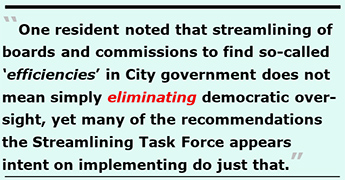 Many San Franciscans who spoke during public comment on September 3 rightly testified that changes the Streamlining Task Force are considering right now mirror precisely rationales in the “Prop. D” ballot measure voters rejected last November and had not wanted when they passed “Prop. E” instead. Sadly, this Streamlining Task Force is attempting to implement the same “reforms” voters overwhelmingly rejected at the ballot box!
Many San Franciscans who spoke during public comment on September 3 rightly testified that changes the Streamlining Task Force are considering right now mirror precisely rationales in the “Prop. D” ballot measure voters rejected last November and had not wanted when they passed “Prop. E” instead. Sadly, this Streamlining Task Force is attempting to implement the same “reforms” voters overwhelmingly rejected at the ballot box!
One resident noted that streamlining of boards and commissions to find so-called “efficiencies” in City government does not mean simply eliminating democratic oversight, yet many of the recommendations the Streamlining Task Force appear intent on implementing do just that.
Doug Engmann — a former president of San Francisco’s Planning Commission — testified that every recommendation presented for altering the Police Commission is essentially what was in “Prop. D” rejected by voters. Engmann warned that if the Streamlining Task Force puts those changes in a future ballot measure to reform commissions, the ballot measure won’t pass.
The Streamlining Task Force is essentially on a penny-wise, pound-foolish fool’s errand, and acting without key questions having been answered yet about additional studies that haven’t been performed, as the BLA recommended be done.
Some Streamlining Task Force members appear to be using “motivated reasoning,” the cognitive process where people interpret information in a biased way to reach their desired predetermined conclusion, rather than seeking objective truth.
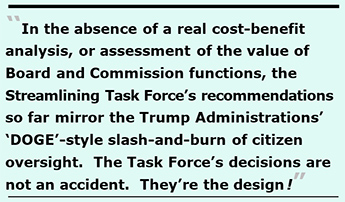 Task Force members may not have read — assuming they are even aware of them — the responses in the 73 Boards and Commissions surveys returned from the separate questionnaires City Administrator staff sent seeking self-assessments. City Administrator staff are still debating whether they have the time and resources to post online on the Streamlining Task Force’s web site the 73 surveys returned, but the Westside Observer has obtained a handful of the questionnaire responses under a public records request. If they are not posted on-line, it will signal they’re being kept secret, rather than posted to preserve the historical record.
Task Force members may not have read — assuming they are even aware of them — the responses in the 73 Boards and Commissions surveys returned from the separate questionnaires City Administrator staff sent seeking self-assessments. City Administrator staff are still debating whether they have the time and resources to post online on the Streamlining Task Force’s web site the 73 surveys returned, but the Westside Observer has obtained a handful of the questionnaire responses under a public records request. If they are not posted on-line, it will signal they’re being kept secret, rather than posted to preserve the historical record.
Hopefully, when the Streamlining Task Force’s recommendations reach the Board of Supervisors in January, cooler heads will prevail and reject most of this nonsense.
In the absence of a real cost-benefit analysis, or assessment of the value of Board and Commission functions, the Streamlining Task force’s recommendations so far mirror the Trump Administrations’ “DOGE”-style slash-and-burn of citizen oversight. The Task Force’s decisions are not an accident. They’re the design!
Start voicing your concerns, by participating in the Task Force’s meetings and their deliberations now, before it’s too late!
-- -- -- -- -- -- -- -- --
Postscript: Foxes Guarding the Henhouses
Some astute San Francisco political observers worst fears may have suddenly become more real!
After submitting this article on September 9 for publication, the Westside Observer published it online on Friday, September 12. After it appeared on-line, two new wrinkles surfaced.
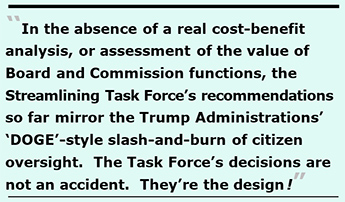 First, on September 10 Task Force Co-Chair Jean Fraser, appointed to the Task Force by Mayor Lurie, suddenly resigned from the Task Force. Her resignation letter sent on Thursday evening after 5:00 p.m. to the Mayor’s Office and published Thursday night on the Board of Supervisors meeting agenda for September 16, read in part: “The time demands of the Task Force exceed what I am able to give at this time. Accordingly, I need to resign.”
First, on September 10 Task Force Co-Chair Jean Fraser, appointed to the Task Force by Mayor Lurie, suddenly resigned from the Task Force. Her resignation letter sent on Thursday evening after 5:00 p.m. to the Mayor’s Office and published Thursday night on the Board of Supervisors meeting agenda for September 16, read in part: “The time demands of the Task Force exceed what I am able to give at this time. Accordingly, I need to resign.”
Fraser’s timing couldn’t have been worse. After all, the Task Force’s five meetings between September 3 and November 4 were scheduled to hear the five categories of types of body groups, to debate on a body-by-body basis each of the remaining 113 Boards and Commissions that weren’t already decided for the “Inactive Bodies” category.
That left the Mayor in a lurch to quickly identify and appoint a qualified replacement for Fraser. The replacement member will have to scramble to come up to speed reading the various “evaluation criteria” and multiple categories of “templates” to quickly learn the Task Force’s procedures for the body-by-body deliberations. It’ll be a difficult learning curve to digest hundreds of pages of previous written materials the Task Force has generated to date to get up to speed with the other four Task Force members!
The Task Force has been meeting since February. Fraser should have known at the time she was appointed just how much time would be involved in evaluating what to do with the 115 Boards and Commissions. She should never have accepted the Mayor’s appointment if her time wasn’t going to be available! Fraser’s resignation leading to changing horses in the middle of a stream is doing an injustice to all of the remaining Boards and Commissions not yet evaluated, and to all San Franciscans writ large.
The second wrinkle surfaced after 8:00 p.m. Friday night on September 12. City Administrator staff posted online version #3 of an 80-page document presenting recommendations about retaining, eliminating, or combining 20 Boards and Commissions to be debated at the Task Force’s September 17 meeting.
So far, members of the public have been led to believe that “combining” any given policy body with another policy body would involve consolidating the functions of two given bodies into another related policy body.
That has apparently just changed!
The new document’s metadata shows its author is Henry O’Connell, a Performance Analyst in the City Controller’s Office apparently collaborating with Rachel Alonso, the Project Director from the City Administrator’s Office who is the lead staff support person to the Streamlining Task Force. O’Connell’s revisions were completed at 7:24:46 p.m. Friday night, and apparently then uploaded to the Task Force’s web page.
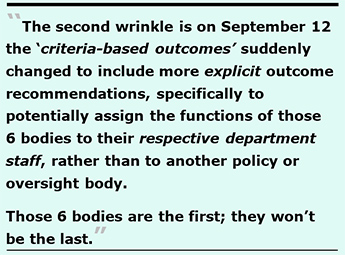 Until September 5, the first page of two- to four-pages devoted to each policy body contained a one-line box titled “Criteria-based outcomes” at the top, recommending whether to retain, eliminate or combine a given governance or policy body, in a curt two- or three-word phrase.
Until September 5, the first page of two- to four-pages devoted to each policy body contained a one-line box titled “Criteria-based outcomes” at the top, recommending whether to retain, eliminate or combine a given governance or policy body, in a curt two- or three-word phrase.
On September 12 that suddenly changed, and for 6 bodies that first box at the top has been expanded to include more explicit outcome recommendations, specifically to potentially assign the functions of those 6 bodies to their respective department staff, rather than to another policy or oversight body. That will drastically reduce citizen involvement, because City staff will be more reluctant to engage with members of the public than their previous oversight bodies did taking public comment during public meetings.
The six bodies include the Urban Forestry Council, the SFMTA Citizens’ Advisory Committee (CAC), the Bicycle Advisory Committee, the Mission Bay Transportation Improvement Fund Advisory Committee, the SFPUC’s CAC, and PROSAC which advises the Rec and Parks Department and the Rec and Parks Commission.
Those 6 bodies are the first; they won’t be the last.
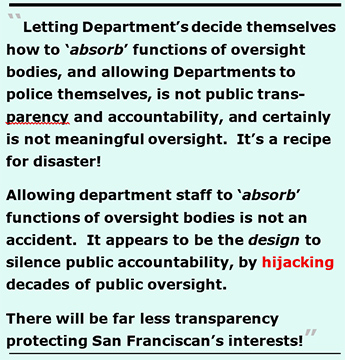 The new 80-page recommendation posted online Friday night proposes handing those 6 bodies functions off to their respective City departments. Letting Department’s decide themselves how to “absorb” functions of oversight bodies, and allowing Departments to police themselves, is not public transparency and accountability, and certainly is not meaningful oversight!
The new 80-page recommendation posted online Friday night proposes handing those 6 bodies functions off to their respective City departments. Letting Department’s decide themselves how to “absorb” functions of oversight bodies, and allowing Departments to police themselves, is not public transparency and accountability, and certainly is not meaningful oversight!
This is a recipe for disaster that only foxes salivating over the thought of their next chicken dinner with a side dish of feathers, could love!
Similar to what my colleague Brian Browne has noted, the City Administrator’s staff recommendation to the Streamlining Task Force to allow department staff to “absorb” functions of oversight bodies is not an accident. It appears to be the design to silence public accountability, by hijacking decades of public oversight.
Given the pressure on City employees to “go along to get along” with their managers and whoever is the current Mayor, departmental staff will be too afraid of losing their jobs to challenge their department managers by defending the policy body functions absorbed, so there will be far less transparency and oversight in protecting the interests of San Franciscans!
This will lead directly to eviscerating Board and Commission oversight of City Hall, just as the astroturf backers of “Prop. D” had wet dreams about last November!
A Cautionary Tale …
“Proposition P” in 2002 was put on the ballot to create a citizen-led “Revenue Bond Oversight Committee” (RBOC) as a watchdog over the SFPUC, which is self-regulated — which means it is effectively unregulated. RBOC was designed to close that gap and provide the public with true, independent oversight.
My Westside Observer colleague, Brian Browne, was the author of, primary ballot measure proponent of, “Prop. P.” He served on RBOC for a number of years.
As of mid-2025, the SFPUC has reportedly issued over $8.5 billion in outstanding borrowing, most of which has been through revenue bonds.
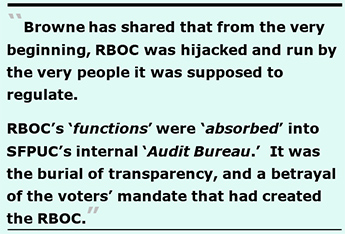 Browne has shared that from the very beginning, RBOC was hijacked and run by the very people it was supposed to regulate. That hijacking was relentless. San Francisco officials apparently decided it was easier to erase the RBOC when the Board of Supervisors recommended sunsetting RBOC in January 2025, than to allow public oversight and accountability.
Browne has shared that from the very beginning, RBOC was hijacked and run by the very people it was supposed to regulate. That hijacking was relentless. San Francisco officials apparently decided it was easier to erase the RBOC when the Board of Supervisors recommended sunsetting RBOC in January 2025, than to allow public oversight and accountability.
RBOC’s “functions” were shifted — a.k.a, “absorbed” — into SFPUC’s internal “Audit Bureau,” which holds no public meetings. That wasn’t DOGE-style reform, or government efficiency. According to Mr. Browne, it was the burial of transparency, and a betrayal of the voters’ mandate, since 64% of San Francisco voters had passed “Prop. P.” Unfortunately, our current crop sitting on San Francisco’s Board of Supervisors gave the green light to eliminating RBOC (including D-4 Supervisor Joel Engardio, who hopefully will lose his recall election on September 15)!
Browne says: “This was never about efficiency. It was about hiding inconvenient truths and protecting the powerful.”
He says the story cannot be fully vented without details of the subversion — falsified RBOC meeting minutes, illegal maneuvers, acting without RBOC committee protocols, and the continual betrayal of the voters’ will. At age 90, he’s working on a thorough review of the hell he endured for more than eight years, because it’s time the record is set straight.
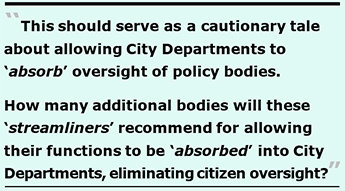 This should serve as a cautionary tale about allowing City Departments to “absorb” oversight of policy bodies. And it is a warning about might become of San Francisco’s “Citizen’s General Obligation Bond Oversight Committee” (CGOBOC) that is charged with monitoring every G.O. Bond put before San Francisco voters, also numbering in the billions of dollars to fund key City infrastructure projects — everything from affordable housing bonds, to Parks bonds, the Laguna Honda Hospital and SFGH rebuild projects and other healthcare facilities, and bonds for SFDPW’s road and street repairs.
This should serve as a cautionary tale about allowing City Departments to “absorb” oversight of policy bodies. And it is a warning about might become of San Francisco’s “Citizen’s General Obligation Bond Oversight Committee” (CGOBOC) that is charged with monitoring every G.O. Bond put before San Francisco voters, also numbering in the billions of dollars to fund key City infrastructure projects — everything from affordable housing bonds, to Parks bonds, the Laguna Honda Hospital and SFGH rebuild projects and other healthcare facilities, and bonds for SFDPW’s road and street repairs.
The fate of CGOBOC will be discussed and initially decided during the Streamlining Task Force’s November 5 meeting. There’s still 83 bodies that will be decided following the Task Force’s September 17 meeting. How many additional bodies will these “streamliners” recommend for allowing their functions to be “absorbed” into City Departments, eliminating all citizen oversight?
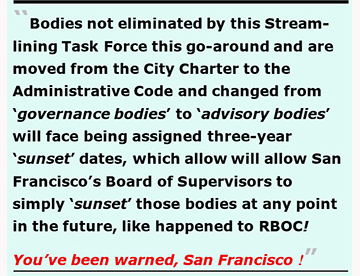 Bodies not eliminated by this Streamlining Task Force this go-around (next January) and are moved from the City Charter to the Administrative Code and changed from “governance bodies” to “advisory bodies” will face being assigned three-year “sunset” dates, which allow San Francisco’s Board of Supervisors to simply “sunset” those bodies at any point in the future, just as the City Supervisors did to the RBOC. You’ve been warned, San Francisco!
Bodies not eliminated by this Streamlining Task Force this go-around (next January) and are moved from the City Charter to the Administrative Code and changed from “governance bodies” to “advisory bodies” will face being assigned three-year “sunset” dates, which allow San Francisco’s Board of Supervisors to simply “sunset” those bodies at any point in the future, just as the City Supervisors did to the RBOC. You’ve been warned, San Francisco!
Get involved now, before it’s too late. It’s now, or never!
nette-Shaw is a columnist for San Francisco’s Westside Observer newspaper, and a member of the California First Amendment Coalition (FAC) and the ACLU. He operates stopLHHdownsize.com. Contact him at monette-shaw@westsideobserver.com.